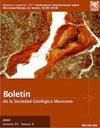Corral(2021)对“中美洲弧发育早期与斑岩相关的高硫化矿化:巴拿马阿祖罗半岛Cerro Quema矿床”的回复
IF 0.4
4区 地球科学
Q4 GEOLOGY
引用次数: 0
摘要
尊敬的编辑,我们感谢Corral(2020)对我们关于巴拿马西南部Azuero半岛Cerro Quema斑岩相关高硫化浅成热液矿化时间的论文的预期兴趣。根据与La Pava中心下生根含铜硫化物矿物密切相关的辉钼矿的三个Re-Os年龄(图1),我们的研究表明,高硫化铜成矿的主要事件发生在马斯特里希特最早的~71 Ma。报告的年龄,加上我们的论文(Perelló et al., 2020)中描述的地质关系,加上一系列区域地质、构造、石化和大地构造考虑,不仅精确地确定了Cerro Quema高硫化矿的斑岩相关性质,但同样重要的是,它们证实了中美洲弧最早阶段的快速演化——从75-73 Ma的俯冲起始到71 Ma的弧稳定和成熟(例如,Buchs等人,2011年a和其中的参考文献)——并将成矿置于区域地球动力学背景中。不考虑Corral(2020)重申的区域地质论据,以支持他之前的遗传解释(例如,Corral等人,2016),并使我们的结论无效,Corral真正关心的是我们辉钼矿年龄的可靠性,这些年龄比他首选的Cerro Quema矿化年龄要老得多。我们认为,Corral(2020)提出的许多观点,包括矿床的区域和当地地质背景以及日期样本,都在Perelló等人(2020)中得到了适当的解决,在这里重复它们是多余的。在Whattam和Stern(2015年、2020年)和Whatam(2018年)中可以找到更多支持这一观点的石化证据。本文章由计算机程序翻译,如有差异,请以英文原文为准。
Reply to “Porphyry-related high-sulfidation mineralization early in Central American Arc development: Cerro Quema deposit, Azuero Peninsula, Panama” by Corral (2021)
Dear Editor, we thank Corral (2020) for his anticipated interest in our paper on the timing of the porphyry-related high-sulfidation epithermal mineralization at Cerro Quema in the Azuero peninsula of southwestern Panama. Our study, based on three Re-Os ages for molybdenite intimately associated with Cu-bearing sulfide minerals from the hypogene roots of the La Pava center (Figure 1), shows that the main event of high-sulfidation Cu mineralization took place during the earliest Maastrichtian at ~71 Ma. The reported ages, together with the geologic relationships described in our paper (Perelló et al., 2020), plus a series of regional geologic, structural, petrochemical, and geotectonic considerations, not only precisely date the porphyry-related nature of the Cerro Quema high-sulfidation mineralization, but are also significant in that they confirm the rapid evolution of the earliest stages of the Central American Arc – from subduction initiation at 75-73 Ma to arc stability and maturation at 71 Ma (e.g., Buchs et al., 2011a and references therein) – and place the mineralization in a regional geodynamic setting. Irrespective of the regional geologic arguments reiterated by Corral (2020) in support of his previous genetic interpretation (e.g., Corral et al., 2016) and to invalidate our conclusions, Corral´s real concern is the reliability of our molybdenite ages, which are much older than his preferred age of mineralization for Cerro Quema. We believe that many of the points raised by Corral (2020), including the regional and local geologic backgrounds of the deposit and the dated samples, were properly addressed in Perelló et al. (2020), and that it would be redundant to repeat them here. Additional petrochemical evidence in support can be found in Whattam and Stern (2015, 2020) and Whatam (2018).
求助全文
通过发布文献求助,成功后即可免费获取论文全文。
去求助
来源期刊
CiteScore
1.40
自引率
12.50%
发文量
34
审稿时长
50 weeks
期刊介绍:
The Boletín de la Sociedad Geológica Mexicana is a completely free-access electronic journal published semi-annually that publishes papers and technical notes with its main objective to contribute to an understanding of the geology of Mexico, of its neighbor areas, and of geologically similar areas anywhere on Earth’s crust. Geology has no boundaries so we may publish papers on any area of knowledge that is interesting to our readers.
We also favor the publication of papers on relatively unfamiliar subjects and objectives in mainstream journals, e.g., papers devoted to new methodologies or their improvement, and areas of knowledge that in the past had relatively little attention paid them in Mexican journals, such as urban geology, water management, environmental geology, and ore deposits, among others. Mexico is a land of volcanos, earthquakes, vast resources in minerals and petroleum, and a shortage of water. Consequently, these topics should certainly be of major interest to our readers, our Society, and society in general. Furthermore, the Boletín has been published since 1904; that makes it one of the oldest scientific journals currently active in Mexico and, most notably, its entire contents, from the first issue on, are available online.

 求助内容:
求助内容: 应助结果提醒方式:
应助结果提醒方式:


